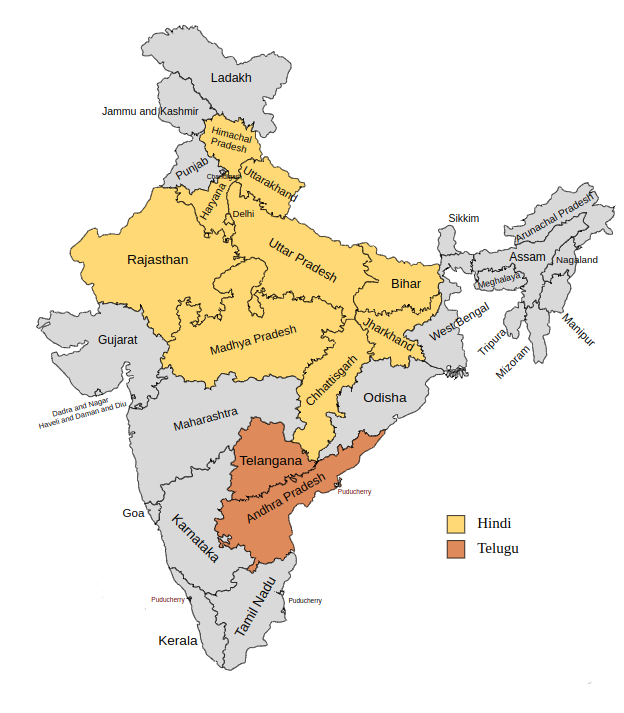Telugu and Hindi: Language Similarities and Differences
Hindi and Telugu are two of the most spoken languages in India. Other major languages in the country include Bengali, Tamil, Marathi, and Gujarati —and several more because India has over 20 officially recognized languages.
In this comparison of Telugu versus Hindi, we will see how they belong to different language families, use different writing systems —and yet have plenty of similar vocabulary words.
We will also discuss Bollywood (the Hindi-language film industry) and Tollywood (the Telugu-language film industry).

As you can see in the map above, Telugu is a South Indian language. It is the official language in the Indian states of Telangana and Andhra Pradesh.
Hindi is spoken in what is known as the “Hindi Belt”, a region in northern India that includes multiple states, along with the national capital, Delhi.
Telugu and Hindi are in different language families
When comparing Telugu versus Hindi on a linguistic level, one of the most notable differences is that they are not in the same language family: Telugu is a Dravidian language, while Hindi is an Indo-Aryan language.
| Language | Language Family | Native speakers in India (Millions) |
|---|---|---|
| Hindi | Indo-Aryan | 528 |
| Bengali | Indo-Aryan | 97 |
| Marathi | Indo-Aryan | 83 |
| Telugu | Dravidian | 81 |
| Tamil | Dravidian | 69 |
| Gujarati | Indo-Aryan | 55 |
| Urdu | Indo-Aryan | 51 |
| Kannada | Dravidian | 44 |
| Odia | Indo-Aryan | 38 |
| Malayalam | Dravidian | 35 |
| Punjabi | Indo-Aryan | 33 |
| Assamese | Indo-Aryan | 15 |
Telugu and Hindi both hold the distinction of being the most widely spoken languages within their respective language families.
- Telugu is the most widely spoken Dravidian, followed by Tamil, Kannada, and Malayalam.
- Hindi is the most spoken Indo-Aryan language, followed by Bengali, Punjabi, and Marathi.
Indo-Aryan languages are part of the broader Indo-European language family. That means that Hindi is distantly related to English, which is also an Indo-European language.
Telugu, in contrast, is not related to English.
Based on this, an English speaker will likely find Hindi slightly easier to learn than Telugu.
Vocabulary comparison
Despite belonging to different language families, Hindi and Telugu have many similar vocabulary words. The reason is that Telugu has been heavily influenced by Sanskrit, an ancient Indian language that belongs to the same Indo-Aryan language family as Hindi.
An estimated 80% of Telugu vocabulary words come from Sanskrit. Sanskrit is also the origin of a large part of Hindi vocabulary terms.
| English | Hindi | Telugu |
|---|---|---|
| love | प्रेम (prem) | ప్రేమ (prēma) |
| happiness | आनंद (ānand) | ఆనందం (ānandam) |
| path | मार्ग (mārg) | మార్గం (mārgaṁ) |
| fruit | फल (phal) | పండు (paṇḍu) |
| peace | शांति (śānti) | శాంతి (śānti) |
| heart | दिल (dil) | గుండె (guṇḍe) |
| fire | आग (aag) | అగ్ని (agni) |
| forest | वन (van) | అడవి (aḍavi) |
| river | नदी (nadī) | నది (nadi) |
| song | गाना (gānā) | పాట (pāṭa) |
| sleep | नींद (nīnd) | నిద్ర (nidra) |
| king | राजा (rājā) | రాజు (rāju) |
Writing systems
Telugu is commonly written in the Telugu script, whereas Hindi is written in the Devanagari script. Despite their distinct appearances, they have a common origin as they evolved from the ancient Brahmi script.
The Telugu script uses mostly curved lines, whereas the Devanagari script used for Hindi has more straight lines, including a horizontal line (called a shirorekha) which connects the top of adjacent characters.
Bollywood produces Hindi movies; Tollywood makes them in Telugu
Watching movies can enhance the language learning experience, and learners of Hindi and Telugu are in luck as both languages have their own vibrant film industries.
Most Westerners are familiar with Bollywood, the Hindi-language film industry. The term is a fusion of “Bombay” (the former name of Mumbai) and “Hollywood”.
Similarly, the Telugu language also has its film industry named Tollywood, a fusion of “Telugu” and “Hollywood”. Tollywood is based in the city of Hyderabad, the capital of the state of Telangana.
It's worth noting that the term Tollywood can also refer to Bengali-language cinema. In that context, the word is a combination of “Tollygunge” (a neighborhood in Kolkata, West Bengal) and “Hollywood”.
Exclusive and inclusive “we” pronouns
One of the differences between Telugu and Hindi is that Tegulu has two forms of the “we” pronoun.
The exclusive form of the pronoun “we” refers to a group that excludes the person being spoken to. In Telugu, this exclusive pronoun is “మేము” (mēmu).
In contrast, the inclusive “we” pronoun, which is “మనము” (manamu) in Telugu, includes the person being spoken to.
In linguistics, this distinction between exclusive and inclusive pronouns is called clusivity. It is a feature that is widespread among the family of Dravidian languages to which Tegulu belongs.
Telugu is an older language than Hindi
Telugu is a language that has existed for well over 2,000 years. In fact, Telugu is one of the six officially recognized classical languages in India. The other five are Sanskrit, Tamil, Kannada, Malayalam, and Odia.
In contrast to Telugu, Hindi gradually developed into a distinct language at a later point in history, emerging after the 7th century CE. While Hindi has roots in ancient languages like Sanskrit, it did not emerge as a separate language until more than one thousand years after the development of Telugu.
Links